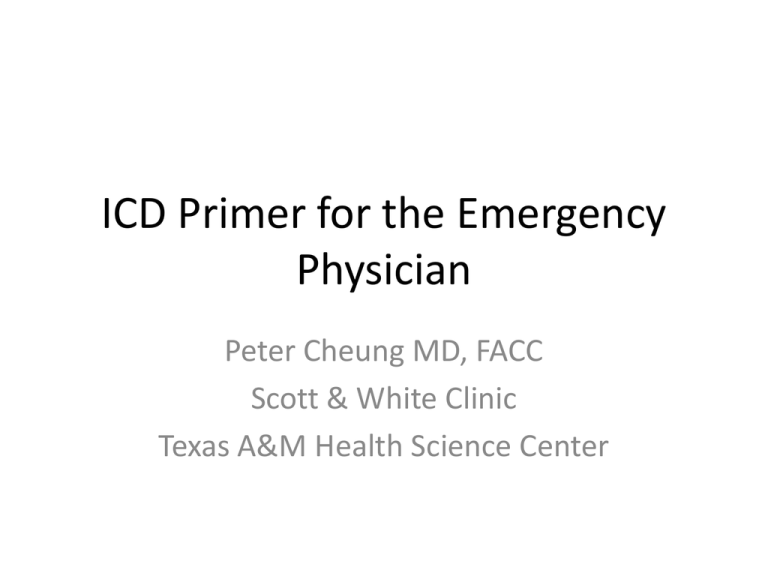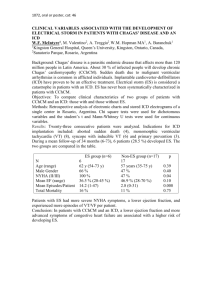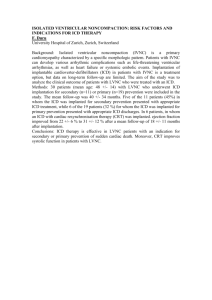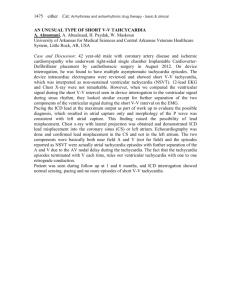
ICD Primer for the Emergency
Physician
Peter Cheung MD, FACC
Scott & White Clinic
Texas A&M Health Science Center
• 62 year-old male with history of ischemic
cardiomyopathy presented to the ER after 2
ICD shocks. He feels well otherwise with no
symptom.
Differential Diagnosis of ICD shock
• Appropriate ICD shocks for VT/VF
• Non ventricular arrhythmia (sinus tach, atrial
tach, SVT, AFIB/Flutter)
• Noise in the ventricular lead mistaken for VF
• T wave over sensing (double counting)
• Myopotential of the diaphragm
Current U.S. Manufacturers
Functions of ICD
Primary Function
Terminates VT
○ Antitachycardia Pacing
○ Shock
Terminates VF
○ Shock
Secondary Function
Atrial pacing- sinus node dysfunction
Ventricular pacing- AV block (increased dyssynchrony of
the left ventricle)
Additional Specialized Function
Left ventricular pacing for resynchronization
Bradycardia support
• Most devices are programmed to minimize
pacing
– VVI, DVI, DDI (inhibited mode)
• Ventricular pacing is not encouraged unless
– there is specific indication (e.g. heart block)
– the device is biventricular (both RV and LV leads
are present for resynchronization)
Tachycardia Intervention
• Antitachycardia Pacing- burst pacing the
ventricle at a rate slightly fasting than the
tachycardia to terminate VT (has no effect on
VF).
• Shock- effective for both VT and VF.
Shock
DETECT
SHOCK
CHARGE
Antitachycardia Pacing (ATP)
BURST PACING
ICD Programming
• “VT/VF” are defined by rate, not mechanism (ICD vernacular)
• 1-3 Zones
– Single Zone- “VF”, defined usually as a rate of > 180 bpm (usually,
programmable)
• Device defined “VF” in reality could be any rhythm with rate > programmed
rate, not necessarily real VF (ex. VT, SVT, AF)
– 2 Zone• “VT” zone which is usually slower, ATP can be programmed.
• “VF” zone which is usually faster, primary therapy is shock.
– 3 Zone• VT1 (slowest) (ex. 130-160bpm), monitor, ATP, shock
• VT2 (faster) (ex. 160-190bpm), ATP, shock
• VF (fastest) (ex. >190bpm), shock
ICD shock
• Appropriate shock- treatment appropriately
directed for VT and VF
• Inappropriate shock- treatment excessive or
unnecessary
Appropriate ICD shocks
• Patients with shock for VT/VF should be
assessed for CHF and ischemia.
– History- symptoms of CHF, ischemia
– Physical- signs of CHF
– EKG
– Labs
• Additional work-up necessarily only if H&P is
(+) or patient is experiencing recurrent shocks.
Inappropriate ICD shock
• Nonfatal rhythm– Sinus tachycardia
– Atrial fibrillation or atrial flutter with rapid
ventricular rate
– SVT
– Atrial tachycardia
• Noise in the ventricular lead mistaken for VF
• T wave over sensing (double counting)
• Myopotential of the diaphragm
Differentiation of Ventricular Arrhythmia from
other Rhythms
• Sinus rhythm- gradual onset, regular, A:V :: 1:1
• Atrial fibrillation- sudden onset, irregular,
move A than V
• SVT- sudden onset, regular, A:V :: 1:1
• VT- sudden onset, regular, often more V than
A, but could also be 1:1 :: A:V
• VF- sudden onset, irregular, move V than A
Differentiation of Ventricular Arrhythmia from
other Rhythms
Regular
Irregular
Onset Gradual
Onset Sudden
Sinus tach
Atrial tach/SVT
VT (diff by more
V than A)
AF- HR < 200
VF- HR > 200
(diff by V rate)
Differentiation of Ventricular Arrhythmia from
other Rhythms
• V>A
• If present, highly specific for VT
• 12-lead EKG equivalent: VA dissociation
• If absent, (i.e. A:V :: 1:1), it doesn’t mean SVT.
It still could be VT with 1:1 VA conduction
2 Strips of VT
Morphology
• Similar to how clinician diagnosed VT.
• QRS morphology of tachycardia and sinus
beat is compared.
• If similar, assume SVT; if dissimilar,
assume VT.
• Pitfall #1- aberrancy may be
misdiagnosed as VT.
• Pitfall #2- VT with similar morphology
with sinus rhythm may be missed.
Criteria used to diagnose VT/VF
•
•
•
•
•
V>A
Onset: sudden vs gradual
RR interval: regular vs irregular
Morphology
PR Logic (Medtronic)
• Most inappropriate ICD shocks for nonfatal
arrhythmia may be corrected by
reprogramming the device to recognize the
nonfatal arrhythmia and withhold therapy
(SVT discrimination).
Inappropriate ICD shock
• Nonfatal rhythm– Sinus tachycardia
– Atrial fibrillation or atrial flutter with rapid
ventricular rate
– SVT
– Atrial tachycardia
• Noise in the ventricular lead mistaken for
VF
• T wave over sensing (double counting)
• Myopotential of the diaphragm
Noise in the ventricular lead mistaken
for VF
ICD lead fracture
Noma, M. Int Heart J, Sept 2005
ICD lead fracture
Noma, M. Int Heart J, Sept 2005
ICD lead fracture
• Admit to telemetry bed.
• Turn ICD off.
• Consult for new ICD lead implant +/- old ICD
lead extraction.
Inappropriate ICD shock
• Nonfatal rhythm– Sinus tachycardia
– Atrial fibrillation or atrial flutter with rapid
ventricular rate
– SVT
– Atrial tachycardia
• Noise in the ventricular lead mistaken for
VF
• T wave over sensing (double counting)
• Myopotential of the diaphragm
T wave oversense
Hosaka et al. Inter
Med 48: 1153-1156,
2009
T wave oversense
•
•
•
•
•
Check electrolytes.
Correct electrolytes abnormalities.
Reprogram ICD sensitivity.
Defibrillation test after reprogram.
New pace/sense lead implant if problem
cannot be corrected.
Inappropriate ICD shock
• Nonfatal rhythm– Sinus tachycardia
– Atrial fibrillation or atrial flutter with rapid
ventricular rate
– SVT
– Atrial tachycardia
• Noise in the ventricular lead mistaken for
VF
• T wave over sensing (double counting)
• Myopotential of the diaphragm
Oversensing of diaphragmatic myopotentials leading to inappropriate ventricular fibrillation
detection: stored right ventricular, and shock electrograms (representative figure).
Santos K R et al. Europace 2008;10:1381-1386
Published on behalf of the European Society of Cardiology. All rights reserved. © The Author
2008. For permissions please email: journals.permissions@oxfordjournals.org
• Recurrent sensing of diaphragmatic potential
may require reposition of ICD lead or implant
of new lead away from the diaphragm.
Summary
• Patients with ICD shocks are occasionally seen
in the ER.
• Patients with appropriate ICD shocks for VT/VF
should be assessed for CHF and ischemia.
• Etiologies of inappropriate ICD shocks can be
easily diagnosed with an ICD interrogation.








